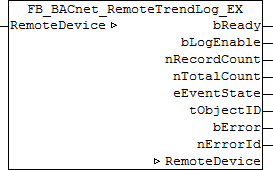FB_BACnet_RemoteTrendLog_EX

Application
The function block FB_BACnet_RemoteTrendLog_EX can be used for read access to a BACnet object of type TrendLog.
VAR_OUPUT
bReady : BOOL;
bLogEnable : BOOL;
nRecordCount : UDINT;
nTotalCount : UDINT;
eEventState : E_BACNETEVENTSTATE;
tObjectID : T_BACnet_ObjectIdentifier:=16#FFFFFFFF;
bError : BOOL;
nErrorId : UINT;
bReady: Notification of general readiness. If this output is set, the other status outputs are valid (PresentValue, Overridden ...). If the output is FALSE, the corresponding function block FB_BACnet_Device does not report "Operational", or the block instance was not linked correctly in the TwinCAT System Manager.
bLogEnable: Logging of values is enabled. See BACnet specification DIN EN ISO 16484-5 for BACnet object TrendLog and property Log_Enable.
nRecordCount: Number of entries of the property Log_Buffer. If "0" is written to the property Record_Count, the Log_Buffer is reset. See BACnet specification DIN EN ISO 16484-5 for BACnet object TrendLog and property Record_Count.
nTotalCount: Total number of entries of the property Log_Buffer. See BACnet specification DIN EN ISO 16484-5 for BACnet object TrendLog and property Total_Record_Count.
eEventState: E_BACNETEVENTSTATE, see BACnet specification DIN EN ISO 16484-5 for BACnet object TrendLog and property Event_State.
tObjectID: Object ID of the BACnet object (object type and object instance).
bError: An error is pending.
nErrorId: see global constants BACnet_Globals.
VAR_IN_OUT
RemoteDevice : FB_BACnet_RemoteDevice;
RemoteDevice: Specification of the instance of the corresponding remote BACnet server block (client). A BACnet adapter can be used for several BACnet clients. See FB_BACnet_Adapter and FB_BACnet_RemoteDevice for further information.